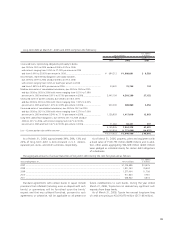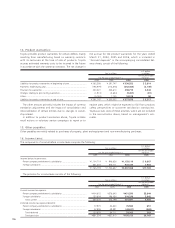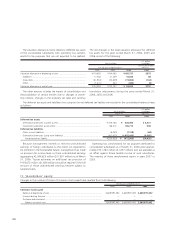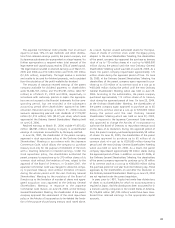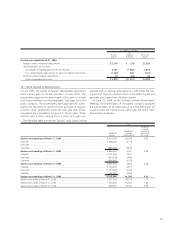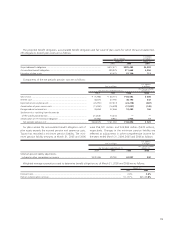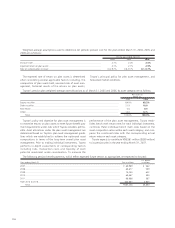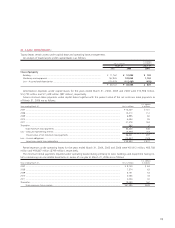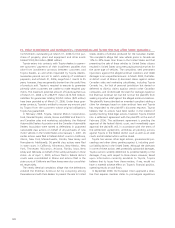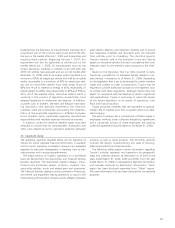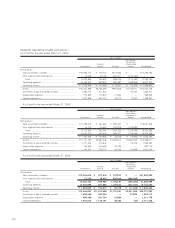Toyota 2006 Annual Report Download - page 114
Download and view the complete annual report
Please find page 114 of the 2006 Toyota annual report below. You can navigate through the pages in the report by either clicking on the pages listed below, or by using the keyword search tool below to find specific information within the annual report.
112
Pension and severance plans—
Upon terminations of employments, employees of the parent
company and subsidiaries in Japan are entitled, under the
retirement plans of each company, to lump-sum indemnities
or pension payments, based on current rates of pay and
lengths of service or the number of “points” mainly deter-
mined by those. Under normal circumstances, the minimum
payment prior to retirement age is an amount based on vol-
untary retirement. Employees receive additional benefits on
involuntary retirement, including retirement at the age limit.
Effective October 1, 2004, the parent company amended its
retirement plan to introduce a “point” based retirement bene-
fit plan. Under the new plan, employees are entitled to lump-
sum or pension payments determined based on accumulated
“points” vested in each year of service.
There are three types of “points” that vest in each year of
service consisting of “service period points” which are attrib-
uted to the length of service, “job title points” which are
attributed to the job title of each employee, and “perfor-
mance points” which are attributed to the annual perfor-
mance evaluation of each employee. Under normal
circumstances, the minimum payment prior to retirement age
is an amount reflecting an adjustment rate applied to repre-
sent voluntary retirement. Employees receive additional bene-
fits upon involuntary retirement, including retirement at the
age limit.
As a result of this plan amendment, the projected benefit
obligation decreased by ¥32,208 million, at October 1, 2004
and resulted in an unrecognized prior service cost, which will
be recognized in future service periods.
Effective October 1, 2005, the parent company partly
mended its retirement plan and introduced the quasi cash-balance
plan under which benefits are determined based on the
variable-interest crediting rate rather than the fixed-interest
crediting rate as was in the pre-amended plan. The amend-
ment did not have a material quantitative impact on the pro-
jected benefit obligation of the parent company as of March
31, 2006.
The parent company and most subsidiaries in Japan have
contributory funded defined benefit pension plans, which are
pursuant to the Corporate Defined Benefit Pension Plan Law
(CDBPPL). The contributions to the plans are funded with sev-
eral financial institutions in accordance with the applicable
laws and regulations. These pension plan assets consist princi-
pally of investments in government obligations, equity and
fixed income securities, and insurance contracts.
Most foreign subsidiaries have pension plans or severance
indemnity plans covering substantially all of their employees
under which the cost of benefits are currently invested or
accrued. The benefits for these plans are based primarily on
lengths of service and current rates of pay.
Transfer to the government of the Substitutional
Portion of the Employee Pension Fund Liabilities—
The parent company and most subsidiaries in Japan had main-
tained employees’ pension funds (EPFs) pursuant to the
Japanese Welfare Pension Insurance Law (“JWPIL”). The EPF
consisted of two tiers, a Substitutional Portion, in which the
EPF, in lieu of the government’s social insurance program, col-
lected contributions, funded them and paid benefits to the
employees with respect to the pay-related portion of the old-
age pension benefits prescribed by JWPIL, and a Corporate
Portion which was established at the discretion of each
employer.
The weighted-average fair value per option at the date of
grant for options granted during the years ended March 31,
2004, 2005 and 2006 was ¥769, ¥1,139 and ¥723 ($6),
respectively. The fair value of options granted, which is
amortized over the option vesting period in determining the
pro forma impact in Note 2, is estimated on the date of grant
using the Black-Scholes option pricing model with the follow-
ing weighted-average assumptions:
19. Employee benefit plans:
2004 2005 2006
Dividend rate...................................................................................................................................... 1.5% 1.5% 2.1%
Risk-free interest rate .......................................................................................................................... 0.4% 1.2% 0.7%
Expected volatility............................................................................................................................... 34% 32% 27%
Expected holding period (years) .......................................................................................................... 5.3 5.3 4.0
The following table summarizes information for options outstanding and options exercisable at March 31, 2006:
Outstanding Exercisable
Exercise Weighted-average Weighted-average Weighted-average Weighted-average Weighted-average
price range Number of exercise price exercise price remaining life Number of exercise price exercise price
Yen shares Yen Dollars Years shares Yen Dollars
¥2,958 – 4,000 946,900 ¥3,078 $26 3.09 946,900 ¥3,078 $26
4,001 – 4,541 3,840,000 4,452 38 4.88 — — —
2,958 – 4,541 4,786,900 4,180 36 4.52 946,900 3,078 26





